|
FISH
One of the most easily obtained foods in northern Norway must be fish. Almost every creek and pond contains fish of various size and kinds and the ocean is crowded with fish. The two most common fresh water fish are the Trout (Salmo trutta) (picture below) and the Arctic char (Salvelinus alpinus) (top one, picture below).
In the eastern part of Troms and Finnmark counties it is also possible to catch Pike (Esox lucius), Grayling (Thymallus thymallus) and Perch (Perca fluviatilis).
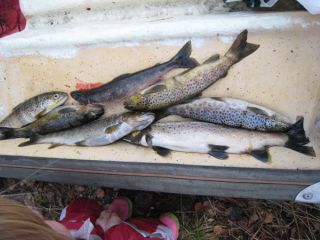
The fishes are not so big but there are many enough to make a meal for me and my family.
The fish could be cooked or fried. I usually fry the fish eating everything but the bones.
Rinsing the fish is easy. I just open it up with a knife from the throat to the anal opening. Rip out the entrails and wash out the dark blood you see along its spine.
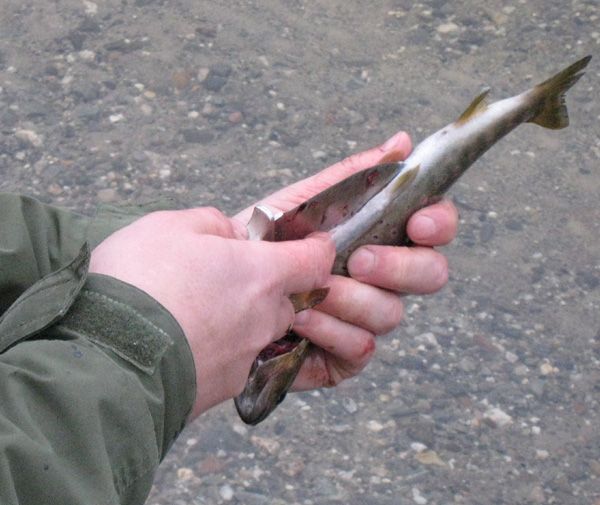
Fry the fish on a hot flat rock or use a frying pan if you have one. Or if you have aluminium foil you could bake it in the embers of the fire.
Another way to rinse the fish is to cut along the spine (on its back side) from its neck to the tail. Cut deep so you can scrape out its entrails. This will leave you with a flat piece of fish. You could now cut or rip out the spine if you like.
This could be laid on a Y shaped spit and fastened with 2 sharpened twigs. The spit is set down by the fire thus cooking the fish.
When I was a kid we often just ripped out the entrails without cutting open the fish. We just pulled the gills and most entrails came out. After we had rinsed it in water we then stuffed the fish with Common Sorel (Rumex acetosa) and fried it. It tasted excellent.
If you get more fish (or meat) than you could eat, smoking/drying is one way to preserve it. If you have salt you rub that on the fish meat, outside and inside. Let it cure for a day or over night. Cut down three 3 meter long poles. Tie them together in on end and erect them like a tipi/lavvu frame. Make a platform of debarked twigs and lay the fish on top. Cover the top of the tipi frame with a tarp (your jerven fjellduk perhaps?) or spruce branches.
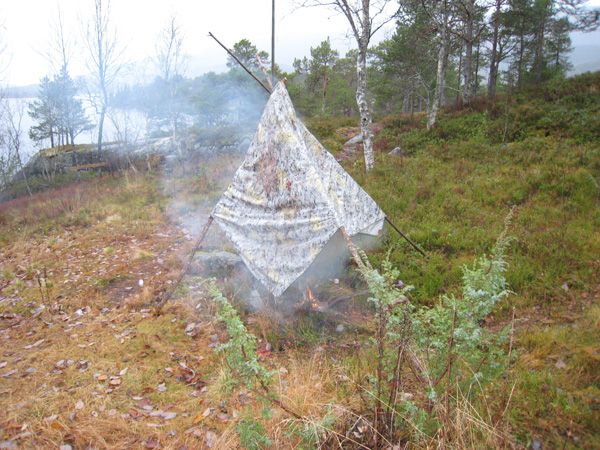
A small smokey fire is built beneath the platform. Make sure the fire is kept going until the fish is dry/smoked.
On the picture above it is not fish but a lightly salted moose heart which is smoked.
In the sea the most common fish is Pollock (Pollachius virens), picture below, Cod (Gadus morhua) and Haddock (Melanogrammus aeglefinus), but countless other fish also inhabit the fjords. All are edible.
Salmon (Salmo salar) inhabit both the sea and fresh water with sea connection.
 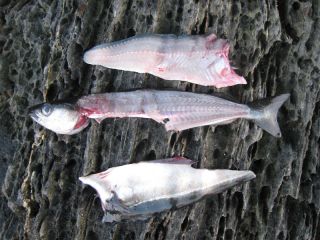
Fish from the sea is usually sliced up and cooked or fileted and fried. The skin of sea fish is usually not eaten.
The rinsed liver (remove the thin skin) from cod is often eaten. Just cook it in a little water, preferably with a little onion, pepper and a splash of vinegar, and sprinkle it over your cooked cod.
Stock fish is a big export article from Norway. It is dried fish, mostly Cod, but also Pollock and Haddock.
The fish is hung on large racks outside in February-March. This time of year the insects are no treath. The fish hangs for about three months before it is taken inside to dry even more. These are then exportet to countries all over the world.
Most people drying fish for them selves just let it hang on the wall until used.
This is an excellent method for long term storage of fish.
Angling
Most people are familiar with angling. This is how most of those who fish in the western world catch fish in the wild.
Nowadays you can buy a wide variety of fishing rods useful for the woods traveller.
I own a Beastmaster BX STC rod from Shimano. It is a 6 piece rod (2,7 meters in total), excellent for packing in the rucksack.
The pieces are stored in a plastic cylinder (58 cm long) with a zippered cap. This prevents the rod from damage during transport. A small reel is also necessary.
I also have a cheap Shakespeare telescopic rod with a closed haspel reel and i doubt the fish notice any difference.
Lures comes in tousands of colors and types and almost every fisherman has an opinion of what is the best lure.
But a few spinners and spoon lures is really all that is needed, allthough I must confess to have plenty more of them than I actually need.
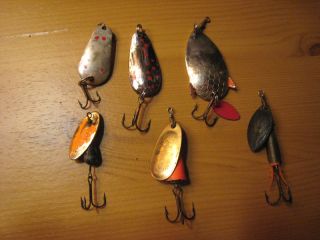
If you don`t want to buy them you could easily make your own. A spoon, a piece of copper could easily be made into a workable lure (below, lures of copper and wood).
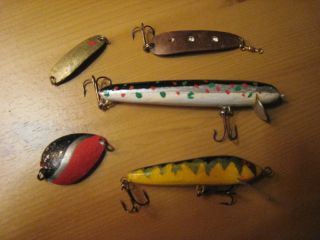
But all you need is basically a rod, a line and a hook. It is possible to make a fishing kit which takes up no more room than a tobacco tin.
Some fishing line, a few assorted hooks and flies, and maybe some sinkers and lures is all that it takes.
The rod could be any long slender tree, cut down and debranched.
Or you could use a tin can (or plastic tube) as a reel and "rod". A hobo fishing kit (picture below). It takes a little training to cast and pull in the line with such fishing equipment, but it works good and take up little room.
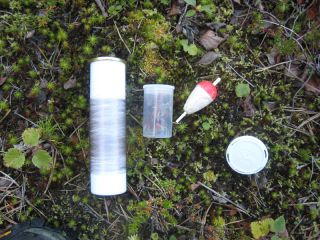
As bait I mostly use Earth worms.
These I usually dig up at home, but they can be found under rocks in the wild too. But don`t go fishing believing you will easily find earth worms, because you most likely won`t.
Larvaes (Cerambycidae) could also be found in rotting logs or between the bark and wood on old pine or spruce stumps.
Big horse flies are also excellent bait.
When I was a kid Ice fishing we usually filled up a jar with small shrimps “Marflo” (Gammarus lacustris) to use as bait. These were easily found under rocks at low tide anywhere along the coast. It is no reason they won`t work in summer too.
Bait for using in salt water (sea) could be small pieces of fish (Herring) or smashed Perrywinkles.
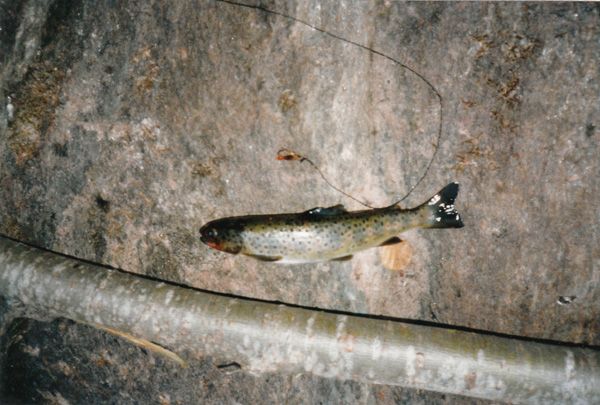
The picture above shows a little trout caught with equipment from an old crappy "survival knife". The rowan used as a fishing pole was cut down with the knife. The fly (a Red Tag, size 12 hook, by the way) I had in the handle along with some fishing line I didn’t use. Instead I used a long string I had wrapped around the handle. Tapered the end to fit the fly hook and I was done. The fish took the fly almost immediately. The creek was no bigger than 1,5-2 meters across. The trout stood in a pool behind a large rock.
It is not much food in such a little fish, but if you catch 2-3 of these a day it will keep starvation at hold for a while.
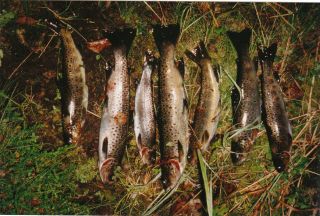
The fish above was caught by active fishing. Another method is to set 10-12 poles (or use trees along the water) with baited hooks and line from the shore. Let them stand out as long as you need them. Take of fish if you get any and add new bait to the hooks when needed.
Where to angle
The fish stands in deeper waters during the day than at night. This is due to the water temperature. The fish will get a little “lazy” if the water temperature is too high. This is the reason the fishing usually is best in the morning or in the evening.
Smaller trout’s usually inhabit small streams and creeks, while bigger fish like deeper water.
Areas around rocks, points, and creeks running in and out of a lake or shallower areas in the lakes are places where the trout’s usually stand. Under trees hanging above the water is also a likely place.
Pikes usually like shallow areas with lots of vegetation (Water Lillies and reeds). In winter though, they are on deeper waters.
Graylings don`t like the parts with most current and usually are found deeper than the trout.
Picture below have some pointers to where the fish might stand.
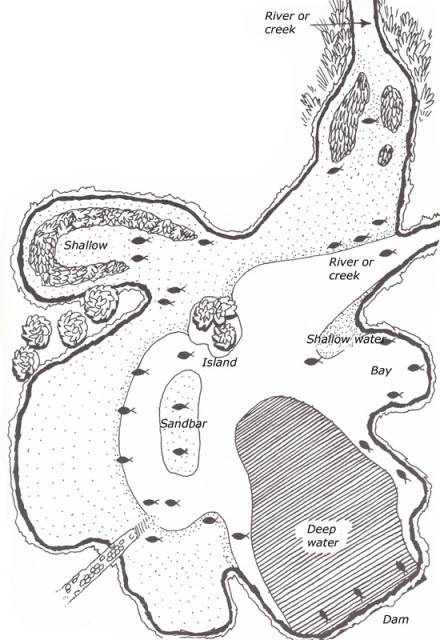
Another good fishing method is the Otter board. It is easily explained a wooden board with chisel shaped ends attached to a main fishing line with 6-12 fishing flies attached. 6 flies are enough when fishing from land. More will only make a mess. Below is a drawing to explain how it is set up.
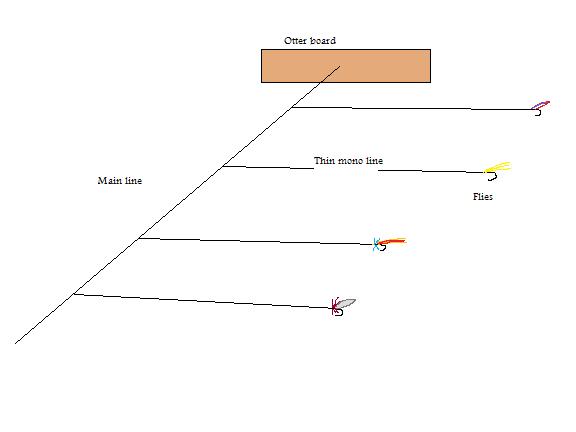
The board is set in the water (a weight, usually metal, holds it vertical) and as you start to walk the board moves from land (because of the chisel shaped ends) dragging the line outwards. You give away line until all hooks are out in the water. The flies are then spread over a large body of water making the use very efficient, and also illegal many places.
Such a board is easy to make yourself. The one in the picture below is a hinged two piece board (for easy packing) I’ve made myself. The weight is a copper tube screwed on to the board. The main line is .50 mm fishing line and I have 8 double hooked flies attached to it with 3-way swivels. The line for the flies is about 1,5- 2 meters long, and about 0.25mm.
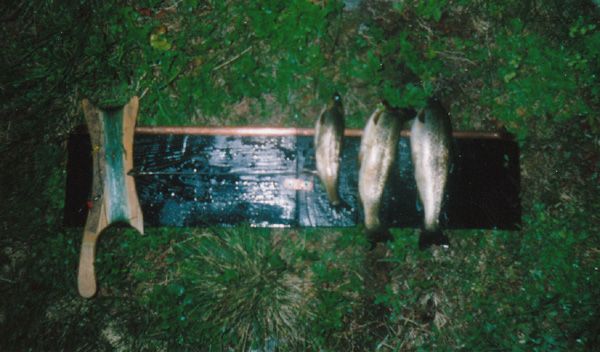
Below is a picture of a commercially produced Otter board. This picture illustrates how the main fishing line is attached to the otter board. You can see some tick metal wire on the board’s side. The metal wire is sort of hinged and can be moved horizontally. The main line is fastened to the horizontal metal rod with a swivel. This way one can walk both ways along the shore without turning the board.
This fishing method is not as easy as it may sound. The trick is to keep in motion all the time, even when you ”reel” in fish which take the flies. You only stop to unhook the fish.
The Otter board is best used on a lake with no vegetation along the shore or one could also use a boat.
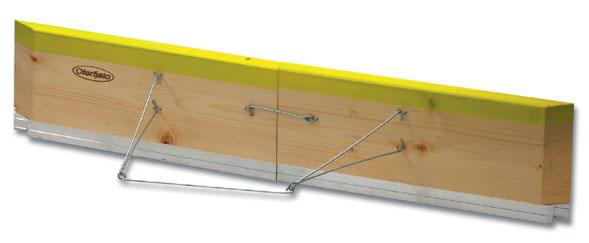
The best way to catch fish is to use a gill net.
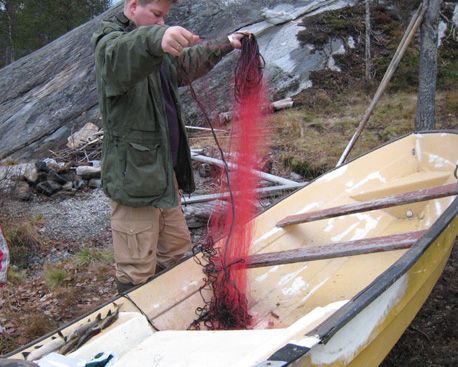
A gill net fish as long as it is out in the water, and you could do other tasks while it works for you. Fishing with a gill net is most effective from late august to may as it is dark and the fish don’t see the net. Obviously in winter you have to use it under the ice. I’ll come back to that later.
Most common fresh water gill nets are 1.5 meters deep and 25 meters long. You can get many different mesh sizes depending on what fish you are after.
It is not necessary to have a long net. I have two nets which are 12.5 meters long and a mesh size intended for very small fish. I often carry one of these with me as a "survival" item when out in the woods. It is so small it can fit in most jacket pockets (it fits mine anyway). My father often used small bits, 3-6 meters, off old worn out gill nets and he just tossed them out from land with a stone in the end. If he didn’t get any fish with his fishing pole it was most often fish in one of the nets.
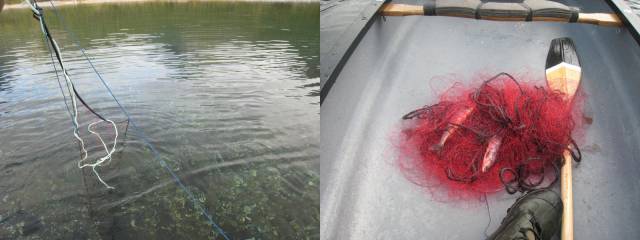
The way I use the nets are easy. Just fasten them in a stone or bush with a short string or rope and row them out. The net will sink to the bottom and start fishing. The next morning I just row to the string, untie it and haul the net up in the boat. Take out the fish (if there are any) and tidy up the net, ready the set out again.
You do not need a boat to use gill nets. You could haul it over a small river/creek or if you have a lot of string and you are two men, you could haul it out over a pond or inlet with the help of the string. One man on each side.
Gill nets are illegal to use many places.
Remember:
When fishing for food it doesn`t matter what size the fish is. For example; one million people along the Lake Tanganyika are dependant on a little sardine like fish wich they have fished for centuries.
Survival isn`t about trophy fishing.
|